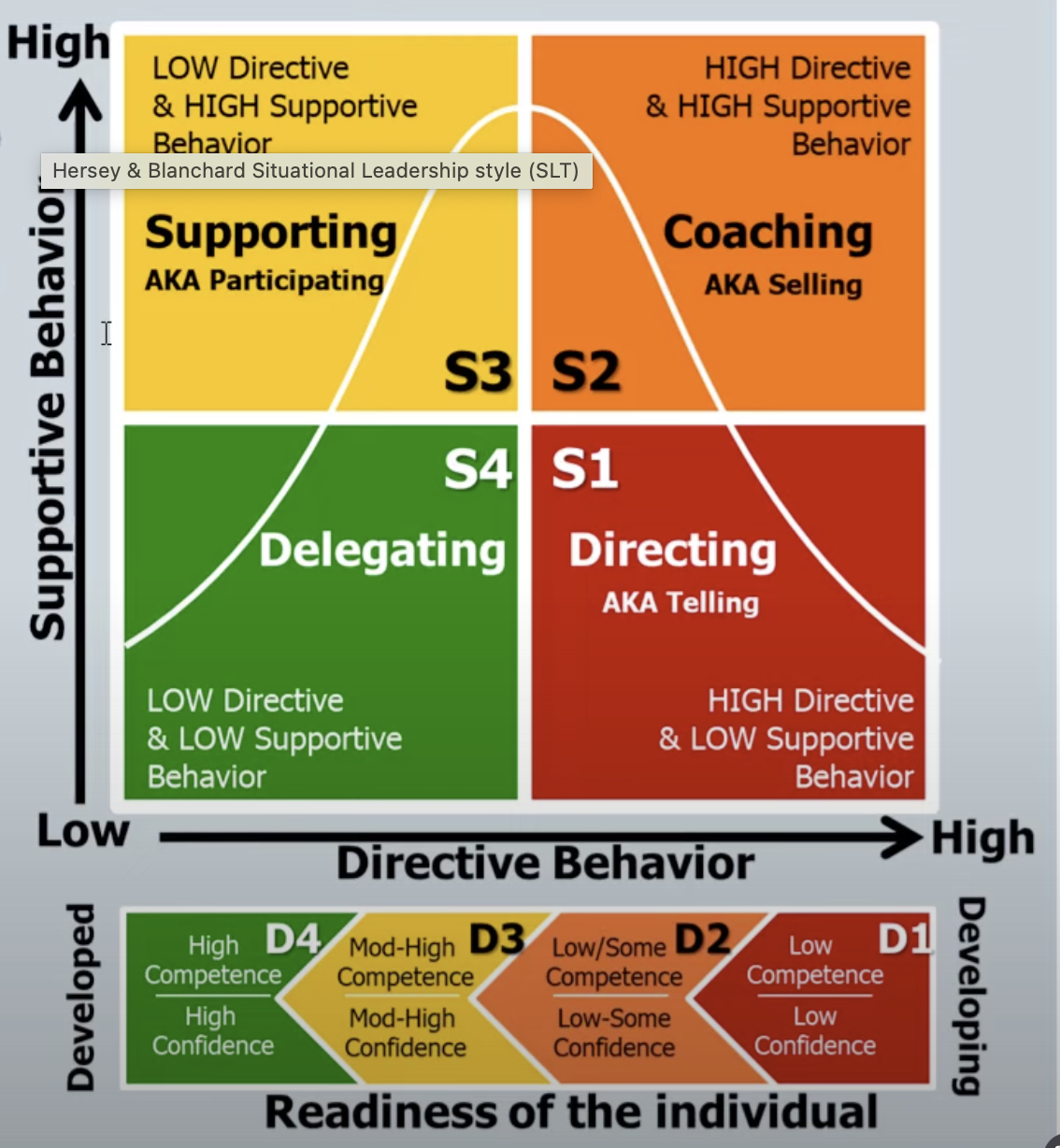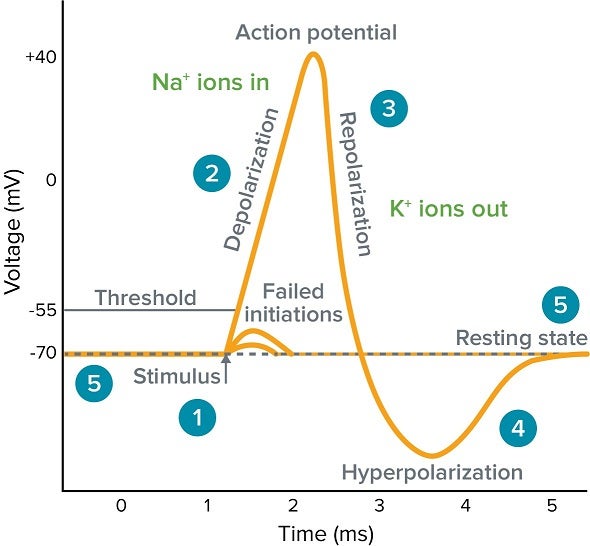AATBS Practice Exam 1
1/68
There's no tags or description
Looks like no tags are added yet.
Name | Mastery | Learn | Test | Matching | Spaced |
|---|
No study sessions yet.
69 Terms
Hersey & Blanchard situational leadership model
optimal style depends on maturity level: ability & willingness to take responsibility
telling style = low ability and low willingness
selling style = low ability and high willingness
participating style = high ability and low willingness
delegating style = high ability and high willingness

sampling error
random (chance) factors = sample may not “mirror” popn in imp characteristics
action potential sequence
 Na channels opn, Na rushes into cell, depolarization (neuron becomes more positively charged), K channels open, K rushes out, reverses depolarization and causes repolarization of cell
Na channels opn, Na rushes into cell, depolarization (neuron becomes more positively charged), K channels open, K rushes out, reverses depolarization and causes repolarization of cell
deferred imitation
doesn’t occur until ~18 mo
ability to rep objects and actions symbolically = form mental rep of object or action
migraine risk
females > males
puberty - midlife
personality = perfectionism, neatness, restraint, ambitiouness
piaget moral development
heteronomous - punishment; authority
autonomous - believe that rules can be changed by consensus
Hans Eysenck
Eysenck's 1952 publication sparked research on psychotherapy outcomes.
Eysenck reported that 66% of patients in eclectic therapy and 44% in psychoanalytic psychotherapy improved versus 72% of those with similar problems who did not receive therapy.
Smith, Miller, & Glass
first to use meta-analysis to examine the effectiveness of psychotherapy. The findings of their 1980 meta-analysis of psychotherapy outcome research contradicted Eysenck's 1952 findings.
Piaget sensorimotor stage
4 - 8 mo = secondary circular reactions
8 to 12 mo = coordinated secodnary circular reactions
12 to 18 mo = tertiary circular reactions
18 to 24 mo.= dev mental representation
Rehm's self-control theory
individuals with depression selectively attend to negative events and to the immediate consequences of their behavior;
make inaccurate internal attribution about their behaviors;
and have low rates of self-reinforcement
depression is attributable to deficits in self-monitoring, self-evaluation, and self-reinforcement.
Bandura's self-efficacy model
depression and other undesirable or maladaptive behaviors are due to a low sense of self-efficacy
Seligman's learned helplessness model
attributes depression to prior exposure to uncontrollable negative events, which leads to a sense of helplessness.
Mothers of babies with insecure/avoidant attachment
tend to either be very impatient and nonresponsive or overstimulating
Mediation
neutral third party (the mediator) uses various tactics to facilitate voluntary agreement between disputants.
facilitates the flow of information between the involved parties and helps them progress toward an acceptable compromise
arbitration
considers the preferences of all involved parties but his/her decision or problem solution is binding.
fact-finding
makes a formal recommendation following a review of the facts, but the recommendation may or may not be accepted by the involved parties
Herzberg 2 factor

Grave's Disease
hyperthyroidism
thyroid produces too much thyroxine
sxs: sped-up metabolism, elevated body temperature, heat intolerance, increased appetite with weight loss, agitation, reduced attention span, fatigue, and emotional liability.
pituitary gland
secretes gonadotropic hormones
where is progesterone secrete by gender
female = ovaries
males = tests
androgen secretion
testes
two types of adrogens secreted: testosterone and androstenedione
estrogen secretion by sex
females = ovaries
males = testes
visual cliff study
social referencing and attachment
The mother's behavior is a variable in this study (she either smiles or makes a fearful face). If attachment has developed, the mother's facial expression will serve as a signal of safety or danger to the infant.
ADHD dx age and settings
symptoms are present before age 12 and that symptoms are present in at least two settings (e.g., at home, school, or work; with friends or relatives; in other activities).
process consultation
organizational development (OD) strategy
focuses on org process - social processes that are a normal par tof hte job
IDs adn alters overt bxs itnerfering w normal social processes
based on assumption that x change is prior and precedes attitude change
Cattle-Horn-Carroll (CHC) Theory of cog abilities
combines Cattle-Horn theor of fluid and crystallized intelligence and Carroll’s three stratum theory of intelligence
influenced SB
10 broad-stratum cog abilities and +70 narrow-stratum cog abilities; ea broad ability composed of several related, but distinct, narrow abilities
Hedwig et al 2008 study of gaze patterns
M and F b/ gazed at faces of member of opposite sex for longest period of time
Byrne's law of attraction
positive linear relationship b/w level of attraction and similarity in attitudes
ppl are reinforced for interacting w others who have similar attitudes b/c it confirms their effectiveness in interpreting world nad produces positive effect
Tower of London
measures attention, working memory, and executive functioning, particularly inhibition.
requires the examinee to move beads, one at a time, so that they end up in a particular goal configuration.
Poor performance has been linked to frontal lobe damage, ADHD, autism, and depression.
neuroleptic malignant syndrome (NMS)
neuroleptic clozapine
symptoms = tachycardia, muscle rigidity, hyperthermia, altered consciousness, and autonomic dysfunction
immediately stop the drug and administer fluids and electrolytes
adult attachment interview
autonomous,
dismissing, and
describe their parents in positive terms that are not substantiated by descriptions of actual interactions
preoccupied
are confused, angry, or passively preoccupied with attachment figures
Interoceptive exposure
exposing the individual to internal bodily sensations (e.g., elevated heart rate, hyperventilation) associated with a panic attack or other anxiety response by having him/her inhale carbon dioxide, spin in a chair, etc.
Interoceptive exposure has been found useful for reducing anxiety associated with panic attacks, PTSD, and other anxiety-related disorders.
rorschach form quality
degree to which an examinee's response matches the actual form (shape) of the inkblot
provides info on the degree of congruence between the response and reality.
rorschach determinants
what aspect of the inkblot determined the response
rorschach location
the extent to which the response is based on an unusual or common detail.
rorschach developmental quality
the extent to which form is well integrated with other determinants
Separation anxiety
severe distress that occurs when a child is separated from their primary caregiver.
begins at about six to eight months of age, peaks in intensity at 14 to 18 months, and then gradually declines.
Credentialing
formal process for determining whether or not a provider meets and maintains qualification standards and provides some legal protection for the MCO.
Freud psychoanalysis process:
confrontation,
clarification,
clarify an issue by, for example, separating a key issue from less important ones
brings a confusing or unclear issue into focus
interpretation, and
links current behavior to unconscious processes.
working through
helps the client gain control over his/her inner conflicts
Sue’s three multicultural counseling competencies
awareness
of own values, beliefs, and stereotypes
knowledge
about worldview of minority and culturally different clients
skills
possesses culturally appropriate counseling skills
"empty nest" usually accompanied by
increase in marital satisfaction related to quality not quantity of tiem spent w partners
precentral gyrus damange
impairment in execution of movement d
damange in postcentral gyrus
loss of sensation
somtaosensory cortex
parietel lobe
precentral sulcus
divides the inferior, middle, and superior frontal gyri from the precentral gyrus.
Damage to the sulcus can result in language and speech problems.
tumor in medial hypothalamus
hypothalamus fx = homeostasis; hormone release to pituitary and other endocrine glands; mediates aggressive responses
lesions/damage = outbursts in aggressive bx
lesions in right hemisphere of cerebral cortex
indifference and apathy
damage to orbitofrontal area of prefrontal cortex
pseudopsychopathy (or orbitofrontal disinhibition syndrome)
emotional lability, poor impulse control, impaired social insight
aggressive outbursts, inappropriate sxual bx, making lewd comments, inappropriate joking
damage to mediofrontal area of prefrontal cortex
pseudodepression
sxs of depression but w/o neg cognitions, vegetative sxs, or dysphoria
damage to dorsolateral area of prefrontal cortex
impaired organization, planning, and insight
"playing it cool"
reaction of African Americans to long-term racial oppression
conceal feelings that might be unacceptable to Whites and that, if expressed, could lead to harm and exploitation.
blended biculturalism
view themselves as having integrated American and ethnic identities.
alternating biculturalism
acknowledge their American heritage but are more strongly influenced by their ethnic background.
factors that predict positive outcomes for high risk (vulnerable) children
Children with positive outcomes tend to be described as very active and socially responsive during infancy.
Factors associated with a positive outcome are related to the child's ability to successfully elicit attention and appropriate care from his/her caretakers.
distributive justice
what a person receives
procedural justice
how perceived goods are allocated
Nathan Ackerman
first to formally adapt and apply psychoanalytic principles to the understanding of the family.
Sophie's (1985/86) theory of lesbian identity development
First awareness, testing and exploration, identity acceptance, and identity integration
achromatopsia
complete loss of color vision resulting from a lack of functioning cone cells
elaboration likelihood model
distinguishes between central and peripheral processing routes
Incentive/reward theory
broader than reinforcement theory
emphasizes the features of the job and work environment that maximize worker interest and satisfaction
attributions related to achievement vary, depending on the sex of the achiever.
1. both males and females viewed ability as the cause of success for males on traditionally masculine tasks,
2. both males and females viewed luck as the cause of success for females on traditionally masculine tasks,
3. both males and females viewed ability as the cause of success for males and females on traditionally feminine tasks.
fluid surrounding auditory hair cells
potassium
effects of maternal depression on infant development
children of depressed mothers are at higher risk for psychopathology and may show symptoms of disturbance as early as three months of age.
Sue et al (1991) racial/ethnic tx outcomes
Hispanic Americans had the best outcomes, followed by Anglo Americans, Asian Americans, and, lastly, African Americans
skeletal age by gender
bone maturation; ossification has occurred
girl ahead of boys in skeletal age from birth; gap increases throughout infancy in childhood; explaisn why girls reach full height before boys do
vygotsky’s theory of cognitive development
language development = transition from social (external) speech to private (self-directed) speech to internal speech
% of women who expeirence postpartum depression
10 to 20%
associated factors: difficulty getting pregnant, twins or triplets, premature labor and delivery, pregnancy and birth complications, baby during adolescence
Heinz dilemma
Kohlberg’s study on moral dilemmas
required ss to reason abt dilemma of man choosing to steal a drug to save wife’s life or not
Holland’s theory: differentiation
extent person has clearly defined interests
highly differentiated =high on one interest scales and low on all other scales
good “fit” between interests and job characteristcs of job is most imp for those who are highly differentiated
increases the predictability of the person-environment interaction.